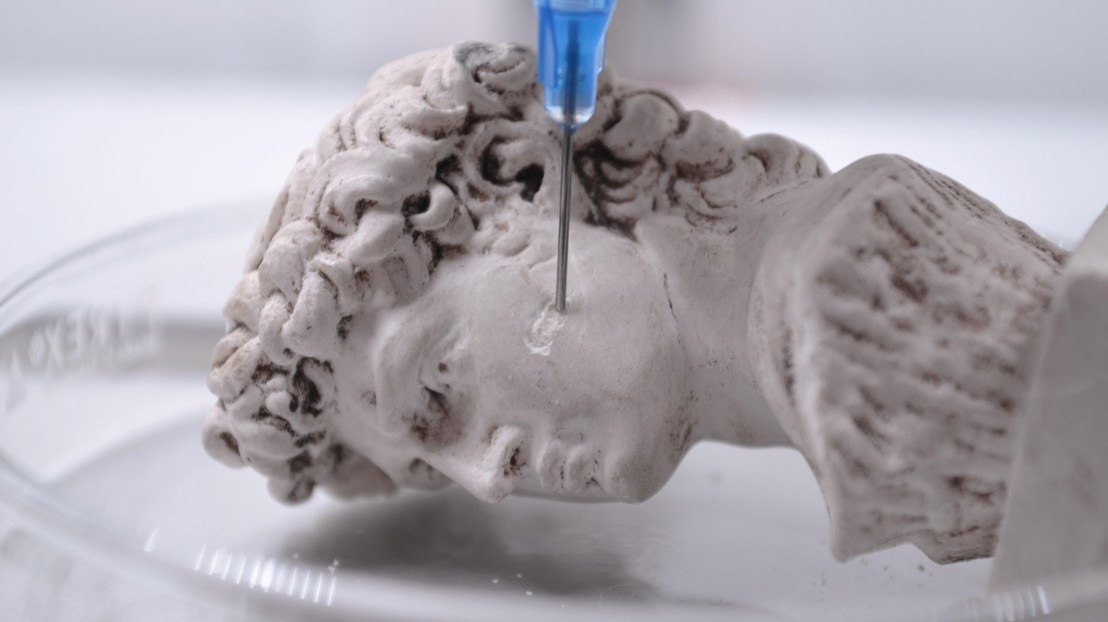Scientists at École Polytechnique Fédérale de Lausanne (EPFL) have demonstrated a technique for three-dimensional (3D)-printing ink that comprises calcium carbonate-generating bacteria.
 The method could be used to restore damaged artworks. Image Credit: © Eva Baur.
The method could be used to restore damaged artworks. Image Credit: © Eva Baur.
The novel 3D-printed mineralized bio-composite is extraordinarily robust, light, and eco-friendly, with a variety of applications from biomedicine to art.
Nature has a surprising ability for creating composite materials that are concurrently strong and light, rigid and porous—like bone or mollusk shells. However, creating such materials in a laboratory or factory—particularly employing eco-friendly materials and processes—is very challenging.
Scientists in the Soft Materials Laboratory at the School of Engineering took inspiration from nature to arrive at a solution. They have initiated a 3D printable ink that has Sporosarcina pasteurii: a bacterium that, when subjected to a urea-containing solution, activates a mineralization process that generates calcium carbonate (CaCO3).
The consequence is that the scientists can utilize their ink—labeled BactoInk—to 3D-print almost any shape, which will then progressively mineralize over a few days.
3D printing is gaining increasing importance in general, but the number of materials that can be 3D printed is limited for the simple reason that inks must fulfill certain flow conditions. For example, they must behave like a solid when at rest, but still be extrudable through a 3D printing nozzle—sort of like ketchup.
Esther Amstad, Head, Soft Materials Laboratory, School of Engineering, École Polytechnique Fédérale de Lausanne
Amstad describes that 3D printing inks comprising tiny mineral particles have earlier been employed to match some of these flow principles but that the ensuing structures happen to be either soft or shrink upon drying, causing cracking and loss of control over the shape of the end product.
“So, we came up with a simple trick: instead of printing minerals, we printed a polymeric scaffold using our BactoInk, which is then mineralized in a second, separate step. After about four days, the mineralization process triggered by the bacteria in the scaffold leads to a final product with a mineral content of over 90%,” Esther Amstad added.
The outcome is a robust and resilient bio-composite, which can be created using a standard 3D printer along with natural materials, and without the extreme temperatures mostly needed for making ceramics. End products no longer comprise living bacteria, as they are immersed in ethanol once the mineralization process is nearly completed.
The technique, which illustrates the first 3D printing ink that employs bacteria to trigger mineralization, has been reported in the journal Materials Today.
Patching up Art, Coral Reefs, or Bone
The Soft Materials Lab’s approach has numerous possible applications spanning a wide range of fields, from ecology and art to biomedicine. Amstad trusts that the restoration of artworks could be significantly enabled by BactoInk, which can also be straightaway injected into a mold or target area—a chip in a statue or a crack in a vase, for instance.
The mechanical properties of the ink lend it the strength and contraction resistance needed to repair a piece of art, as well as stop additional damage while carrying out the restoration process.
The technique’s use of only eco-friendly materials and its ability to create a mineralized biocomposite also make it a favorable candidate for forming artificial corals, which can be employed to help regenerate damaged ocean reefs.
Finally, the fact that the mechanical properties and structure of the biocomposite imitate those of bone could make it stimulating for biomedical applications in the future.
The versatility of the BactoInk processing, combined with the low environmental impact and excellent mechanical properties of the mineralized materials, opens up many new possibilities for fabricating lightweight, load-bearing composites that are more akin to natural materials than to today’s synthetic composites.
Esther Amstad, Head, Soft Materials Laboratory, School of Engineering, École Polytechnique Fédérale de Lausanne
Journal Reference:
Hirsch, M., et al. (2023) 3D printing of living structural biocomposites. Materials Today. doi.org/10.1016/j.mattod.2023.02.001.